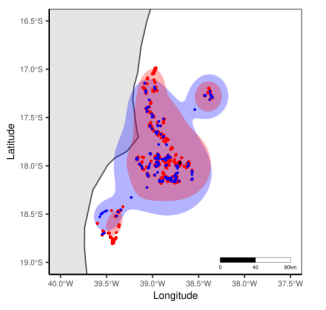Working just with foraging points
59 views
Skip to first unread message
Fiorella Vilela
Mar 18, 2022, 12:39:40 PM3/18/22
to ctmm R user group
Hi all, has anyone used AKDE to estimate foraging areas only? Is that possible or will it have some implications because the amount of data is less? I want to calculate the size of the feeding areas using only the positions where the birds dived to feed.
Thanks!
Christen Fleming
Mar 18, 2022, 1:30:22 PM3/18/22
to ctmm R user group
Hi Fiorella,
I recommend that because it's more biologically relevant and it also segments the behavior, which allows the stationary models to fit better.
Best,
Chris
Fiorella Vilela
Mar 19, 2022, 8:11:48 AM3/19/22
to ctmm R user group
Hi Chirs, thank you very much for the prompt reply.
I was working with the AKDE's and in the attached image I show you my results. The areas estimated with AKDE, especially the blue one, seem to be very large in relation to the point distribution... to generate that kernel I used the parameter weights=TRUE. Is there any possibility that there is an error in those results?
I was working with the AKDE's and in the attached image I show you my results. The areas estimated with AKDE, especially the blue one, seem to be very large in relation to the point distribution... to generate that kernel I used the parameter weights=TRUE. Is there any possibility that there is an error in those results?

Regards
Fiorella
Christen Fleming
Mar 19, 2022, 4:02:26 PM3/19/22
to ctmm R user group
Hi Fiorella,
AKDE predicts future space use under the assumption that the current movement behavior continues. KDE does the same thing, but with the further assumption that the points were sampled IID.
When you only observe a few range crossings and your effective sample size is very low, AKDE's predicted area will be noticeably larger than the observed data, as there is a very good chance that the individual will go somewhere you haven't observed in the future, but the corresponding uncertainty estimate will be comparably large, because you don't really know where that will be. KDE will actually look similar if your nominal sample size were the effective sample size you estimated when running the AKDE analysis.
Empirically speaking, this larger sized area is appropriate for making predictions of space use: https://esajournals.onlinelibrary.wiley.com/doi/abs/10.1002/ecm.1344
and other methods (that assume IID data or estimate the wrong target distribution) will fail to cross validate into the future.
If you want to assess how good you expect this prediction to be, I would look at how well the theoretical and empirical variograms match up.
Best,
Chris
Reply all
Reply to author
Forward
0 new messages
